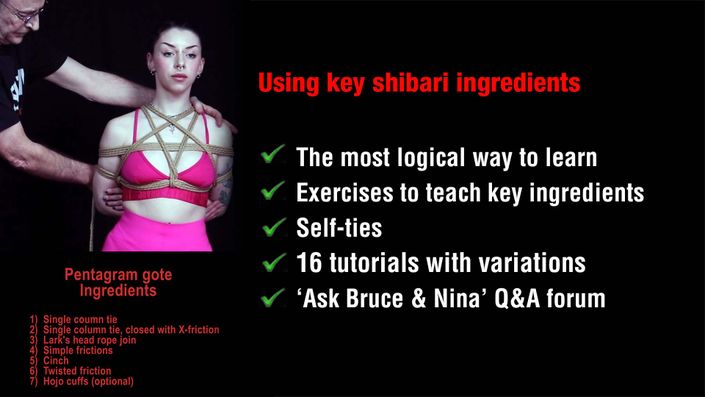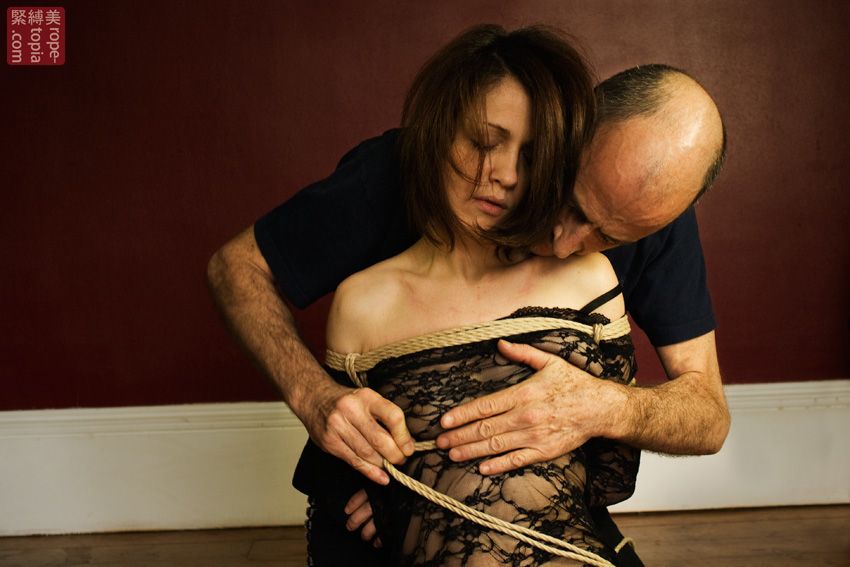
Using key ingredients of shibari
A series of simple ties which enhancing your understanding of shibari ingredients
Using key ingredients
We believe that shibari is most easily understood by learning the key ingredients, e.g. frictions and single column variations, and how they are used, rather than simply learning ties by rote as recipes. Most people find it challenging to learn numerous steps of a tie. It is also very easy to forget steps or make mistakes if you are just learning parrot-fashion. There are rules for using the ingredients which can help you make decisions and spot mistakes.
Once you understand the ingredients, it becomes very easy to be creative and change your recipes. To continue the culinary parallel, if a recipe calls for brown sugar, you will know it is to sweeten the dish. If you don't know that, you will be stumped if you have no brown sugar in the larder. Of course, if you know its purpose, you can substitute another type of sugar or sweetener. The outcome will not be identical but it will be close or, possibly, better.
The purpose of these tutorials is to illustrate this principle and to familiarise you with the common ingredients of shibari. You will also see how they can be varied in the same type of tie or, on different parts of the body, to provide similar functionality but a different look. For example, the first wrap of a TK/gote is used in other of the examples, e.g. the arm binder. A TK/gote is, in essence, a collection of single column ties, albeit closed in different ways. At the wrists, it is a standard single column, whilst the upper wrap is usually closed with an X-friction and, the lower with a square one. This tutorial assumes that you are already familiar with the single and double column ties, which are shown in full detail in our other tutorials.
I used to use the analogy of the components of a Lego or Meccano set but I feel that the culinary simile is more accurate. Lego and Meccano are too rigid, whereas cooking implies greater creativity. Kits limit you to the way components are combined. Cooking allows the same ingredients to be combined but also to be prepared in different ways. Shibari is not just about patterns; the real secret is in how you make the tie feel. In other words, it is all in how you apply the rope. It could be soft and sensual, firm and decisive, hard and nasty or a combination of those techniques. It is so much more than mechanically combining the ingredients or components.
You are encouraged to practice the self-ties and, fundamentals like single and double column ties, to become familiar with the ingredients and to improve dexterity and muscle memory. Whilst, it might sound difficult, once you have mastered the steps, try with you eyes closed; it is a lot easier than it sounds and will help with developing muscle memory.
Your Instructor

Esinem is a shibari artist who has regularly appeared at UK and international events such as Pride, Torture Garden, Erotica, Rubber Ball, Wasteland, Boundcon, Nuit Demonia and recently represented the UK at Japan's first international kinbaku event, Toubaku. He is also known for his teaching both in the UK and internationally and was co-organiser of the London Festival of the Art of Japanese Bondage and BOUND, Europe's premier monthly shibari event.
Over the last few years, he has been improving his skills in Japan with the help some of their best known and respected kinbakushi, Arisue Go, Osada Steve, Kinoko Hajime, Kazami Ranki and, grand master of newaza, Yukimura Haruki. Whilst drawing from classical methods, his style is distinctive and epitomizes the art of communicating with rope, often departing from the typical serenity of shibari shows and flying in the face of tradition to produce some striking and unusual performances.
In addition, he has worked on various videos, e.g. Primal Scream's 2013, artistic collaborations and photo shoots both on and off camera. He has been involved in projects providing inspiration for Tom Ford's 2013 collection and, Raqib Shaw, an acclaimed artist who has exhibited at the Tate, Metropolitan and White Cube galleries.
He contributed to Rope, Bondage & Power, edited by Lee Harrington and is currently involved with a number of documentaries on kinbaku. He is also author of the first English language tutorial DVDs: 'Japanese Rope Bondage: Tying people, not parcels'.
Nina Russ is a London based, shibari performer, rope artist and educator. She became student of Esinem in 2011 and their collaboration gave birth to BOUND shibari night (2012) and ShibariClasses (2015). She had also the fortune to participate at workshops with different Japanese shibari masters, like: Kazami Ranki, Yukimura Haruki, Kinoko Hajime.
She has performed internationally, most notably at the London Festival of the Art of Japanese Rope Bondage and RopeFest in St.Petersburg. In addition, she participates in numerous artistic, fashion collaborations and local performances. Her passion for rope has lead her on a route of discovery of concepts, philosophy, aesthetics and benefits behind this Japanese discipline.
She sees shibari as an art form which creates deep connection between the participants and also aids personal development. Due to its martial arts roots, it brings self-discipline, efficiency, effectiveness and, thus, growth in confidence and awareness. She believes these skills allow a greater focus on the most important aspects: you, your partner and your shared experience.
Course Curriculum
-
StartIntroduction
-
StartSingle and double column self-tie practice (11:15)
-
StartCrotch rope dragon rope (4:32)
-
StartSelf leg tie. dragon rope (4:41)
-
StartSelf leg tie, TK/gote inspired (3:48)
-
StartSelf leg tie, locked friction (2:59)
-
StartBuns up tie (8:29)
-
StartChaotic arm binder (2:57)
-
StartSimple arm binder (3:01)
-
StartSimple arm binder, alternative finish (2:40)
-
StartFuto momo style arm binder (5:15)
-
StartTK/gote style arm binder (2:27)
-
StartLeg spreader (4:00)
-
StartLeg spreader variation (6:29)
-
StartLeg spreader progression (2:53)
-
StartHishi chest harness (8:42)
-
StartHishi continuation (13:50)
-
StartPentagram TK/gote (11:30)
-
StartRefer a friend and you both get a 20% discount
-
StartQ&A forum: 'Ask Bruce and Nina'
